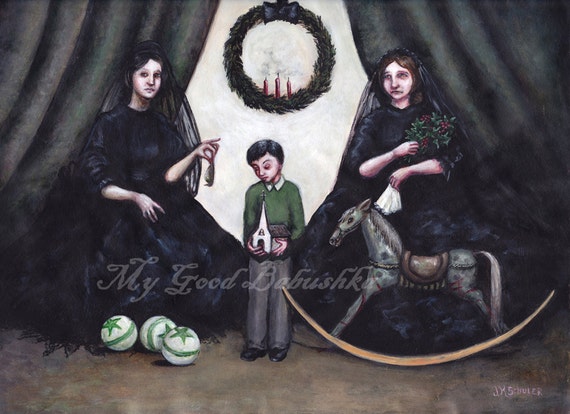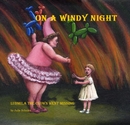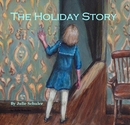Wednesday, March 5, 2014
St. Stephen's Day
This is an acrylic painting on acid-free paper 9" x 11". It is a symbolic painting of St. Stephen and the lore around St. Stephen's Day.
St. Stephen was known as the patron saint of widows, so he is flanked by two women in Victorian mourning dresses. At the feet of the woman on the left sit three balls. St. Stephen is often depicted with three stones to indicate that he was put to death by stoning. Here the three balls stand in for the three stones. The widow on the left is also holding a dead wren. According to lore, St. Stephen was about to escape his captivity when a wren woke up his captors. Since that time, a wren was caught and killed each St. Stephen's Day because it must now take a part of his martyrdom.
St. Stephen is often depicted as a young man holding a miniature church. Here he is depicted as a child, also holding a church in miniature. To the right of St.Stephen is a rocking horse with bleeding legs. St. Stephen's Day, in medieval through Victorian times, was a day to bleed horses in order to preserve their health in the coming year.
Ancient Welsh custom, discontinued in the 19th century, included the "holming" (beating or slashing with holly branches) of late risers and female servants. My widow on the right is holding a branch of holly to remind us of this forgotten tradition.
St. Stephen's Day is the day after Christmas, that is why the candles are just put out in the wreath at the center of the composition.
St. Stephen's Day. Original, one of a kind art by Julie K. Schuler. The "My Good Babushka" watermark in the first picture is not on the actual painting, but is included here for security purposes.
Labels:
art,
Christian martyr,
church,
folklore,
holly,
holming,
horse,
painting,
rocking horse,
St. Stephen,
St. Stephen's Day,
Victorian mourning dresses,
widows,
wren
Subscribe to:
Post Comments (Atom)











No comments:
Post a Comment